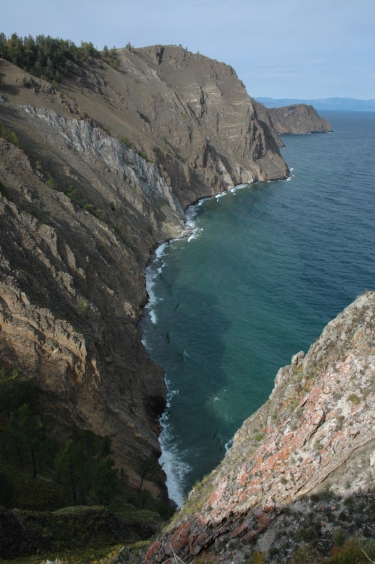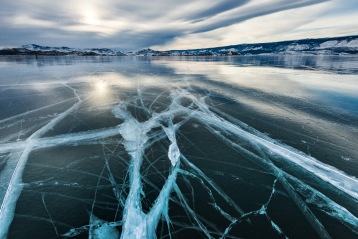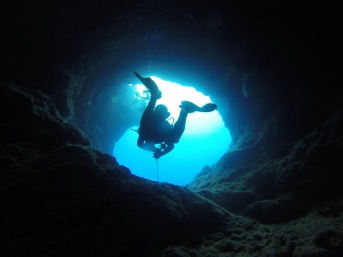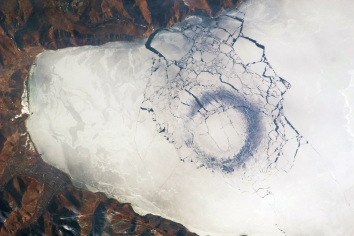I’ve always loved marine biology. Aquatic creatures and plants are so distinct from what we experience normally that they often border on the fantastic. Deep water life is a special treat: it remains a poorly-known frontier, and so excites wonderful, terrible possibilities. We humans have felt the weight of those possibilities for some time, which is why I think there are so many monster stories that come from the water. This month, let’s visit a few in a Siberia.

Lake Baikal, courtesy of Wikimedia commons.
To call Lake Baikal a mere “lake” might be doing it a disservice. Formed by the slowly yawning gap between two tectonic plates, it is the largest, deepest, and most ancient freshwater body on Earth. To be specific, Lake Baikal has more water than all of the U.S. Great Lakes combined, and reaches a depth of 1,642 meters (or, for us Americans, a little over a mile). At 25 million years old, it has been around more than 4 times longer than the human race.
That’s not the only way Baikal is impressive. The lake is also considered one of the world’s clearest–one source says that you can see as far into it as 130 feet. Surrounded by Siberian mountains, it is teeming with rich biodiversity: over 80% of the life in and around Baikal is made up of creatures that can be found nowhere else on earth. In short, the lake is an extraordinary place. It’s no wonder people have attributed magic to it.
Let’s start with the happier stuff. If you take a dip in Baikal’s waters, rumor has it that you’ll live a longer, healthier life–provided you don’t suffer hypothermia (in the winter, the ice can get to be over 6 feet thick). The lake is also associated with a couple of historical celebrities: Genghis Kahn was born on one of its islands, and Jesus himself supposedly once visited, as well. Looking out over the waters, he raised his hand, and proclaimed with satisfaction that “beyond this, there is nothing.” (This was said to account for the problems 19th-century Duaria (the land beyond the lake) had with growing corn.)

A frozen Lake Baikal, © Sergey Pesterev via Wikimedia Commons
Beyond that, Lake Baikal has proved to be a bit of a deathtrap. Earthquakes strike every few years. You can walk over the lake when it freezes, but woe to the man who goes unprepared. In 1920, the retreating White Russian Army attempted the cross, only to find themselves buffeted by freezing winds over the open expanse of ice. Many died of frostbite and hypothermia. Their corpses had to be left behind, frozen to the surface until they sunk with the spring thaw.
Locals living around the lake have reported ghosts boats that appear and disappear without warning, as well as boats (and crew) of their own that disappear. As recently as 2011, 4 experienced men piloting the Yamaha vanished near an area of the lake known as the Devil’s Crater. There, whirlpools are said to suck ships down like toys in a bathtub train. At the bottom of the pools, some whisper, lies Hell.
But out of all the delights that Lake Baikal has to offer, my favorites are the extraterrestrial ones. According to UFO enthusiasts, those deep waters are not going unused.
I’m not well-versed in UFO lore, and so was surprised to learn that it’s common to see crafts around–or in–bodies of water (though “in” would make them Unidentified Submerged or Unidentified Underwater Objects). Lake Baikal is no exception: not only mysterious in its own right, it is one of the biggest UFO hotspots in Russia. The surrounding villages have witnessed hovering lights in various colors and formations, as well as silent discs that have floated low in the sky for so long people threw rocks at them from sheer boredom.
On more than one occasion, these UFOs have dove into the lake to escape human pursuit. For a long time, Baikal was too deep and dangerous for anyone to go after them, or indeed to explore very deep under the surface at all. Thanks to modern technology, that is no longer the not the case.

Some say that the many tight, poorly explored caves under Lake Baikal might be a good extraterrestrial hiding place.
The first reported underwater anomaly came in 1977. A pair of scientists took a submersible some 3900 feet below the surface and turned off their lights to study how far sunlight could penetrate. After a few seconds of darkness, they were blinded by two spotlights shining at them above and at their side. Before the men could figure out where they had come from, the lights went out, leaving them alone in the dark once more.
The second incident happened in 1982, this time with military divers using Lake Baikal as a training ground. In the middle of their drill, a few strange underwater vehicles zipped past them, going much faster than anything the Soviet navy was capable of at the time. The ships were gone long before the soldiers could follow.
Then there was the third–and probably most famous–incident. Just a few days after seeing the strange vehicles, the same navy divers swam right into a group of 3 other, unexpected divers. These were almost 10 feet tall, decked out in silver suits and helmets, but with no other signs of scuba gear.
The men were ordered to capture the swimmers (referred to by the commander as Ihtiander, a shark-boy from modern Russian mythology) . The soldiers tried, but the silver suits evaded them. Each human found himself blasted to the surface of the late, riddled with decompression sickness. 4 of them managed to get in a decompression chamber in time to save themselves. The other 3 died shortly thereafter.
All this came out a few years ago, when (allegedly) military documents describing the event were declassified. The Russian government, of course, claims that nothing of the sort ever happened.

One of the circles in question. Image courtesy of Wikimedia commons and the ISS Crew Earth Observations Experiment
Regardless, interest in the lake and its possible extraterrestrial inhabits persists. In 2009, strange circles in Lake Baikal’s ice led to arguments over what might have created them: global warming or underwater spacecrafts. There’s a lot of stuff to explore, and a lot of people passionate about it. Ex-navy officer and UFO researcher Vladimir Azhazha says it best:
“I think about underwater bases and say: Why not? Nothing should be discarded, skepticism is the easiest way: believe nothing, do nothing. People rarely visit great depths. So it’s very important to analyze what they encountered there.”
What horrors have you found at the bottom of the pool? Share your story in the comments below.
Featured image by Cristian Palmer.





0 Comments
Trackbacks/Pingbacks